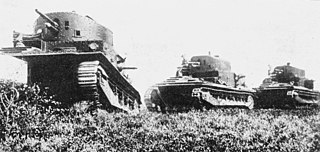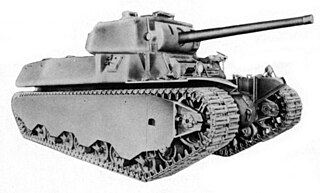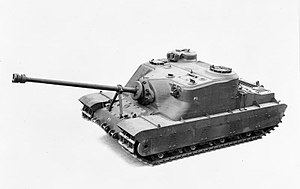
A tank destroyer, tank hunter or tank killer is a type of armoured fighting vehicle, predominantly intended for anti-tank duties. They are typically armed with a direct fire artillery gun, also known as a self-propelled anti-tank gun, or missile launcher, also called an anti-tank missile carrier. The vehicles are designed specifically to engage and destroy enemy tanks, often with limited operational capacities.

The Infantry Tank Mark II, better known as the Matilda, is a British infantry tank of the Second World War.

Panzerkampfwagen VIII Maus was a German World War II super-heavy tank completed in July of 1944. It is the heaviest fully enclosed armored fighting vehicle ever built. Five were ordered, but only two hulls and one turret were completed, the turret being attached before the testing grounds were captured by advancing Soviet military forces.

The Tank, Infantry, Mk IV (A22) Churchill was a British infantry tank used in the Second World War, best known for its heavy armour, large longitudinal chassis with all-around tracks with multiple bogies, its ability to climb steep slopes, and its use as the basis of many specialist vehicles. It was one of the heaviest Allied tanks of the war.

The Centurion was the primary British Army main battle tank of the post-World War II period. Introduced in 1945, it is widely considered to be one of the most successful post-war tank designs, remaining in production into the 1960s, and seeing combat into the 1980s. The chassis was adapted for several other roles, and these variants have remained in service. It was a very popular tank with good armour, mobility, and a powerful main armament.

The Tank, Infantry, Mk III, Valentine was an infantry tank produced in the United Kingdom during World War II. More than 8,000 of the type were produced in eleven marks, plus various specialised variants, accounting for approximately a quarter of wartime British tank production. The many variants included riveted and welded construction, petrol and diesel engines and a progressive increase in armament. It was supplied in large numbers to the USSR and built under licence in Canada. It was used extensively by the British in the North African campaign. Developed by Vickers, it proved to be both strong and reliable.

The Tank, Cruiser, Mk II (A10), was a cruiser tank developed alongside the A9 cruiser tank, and was intended to be a heavier, infantry tank version of that type. In practice, it was not deemed suitable for the infantry tank role and was classified as a "heavy cruiser". It served briefly in World War II.

The Tank, Cruiser, Challenger (A30) was a British tank of World War II. It mounted the QF 17-pounder anti-tank gun on a chassis derived from the Cromwell tank to add anti-tank firepower to the cruiser tank units. The design compromises made in fitting the large gun onto the Cromwell chassis resulted in a tank with a powerful weapon and reduced armour. However, the extemporised 17-pounder Sherman Firefly conversion of the US-supplied Sherman proved easier to produce and, with delays in production, only 200 Challengers were built. The Challenger was able to keep up with the fast Cromwell tank and was used with them.

A casemate is a fortified gun emplacement or armored structure from which guns are fired, in a fortification, warship, or armoured fighting vehicle.

The T28 Super Heavy Tank was an American super-heavy tank/assault gun designed for the United States Army during World War II. It was originally designed to break through German defenses of the Siegfried Line and was later considered as a possible participant in the planned invasion of the Japanese mainland.

The FV 214 Conqueror, also known as Tank, Heavy No. 1, 120 mm Gun, Conqueror was a British heavy tank of the post-World War II era. It was developed as a response to the Soviet IS-3 heavy tank. The Conqueror's main armament, an L1 120 mm gun, was larger than the 20-pounder (83.4 mm) gun carried by its peer, the Centurion. The Conqueror's role was to provide long range anti-tank support for the Centurion. Nine Conquerors were issued for each regiment in Germany, usually grouped in three tank troops. In the British Army both the Conqueror and the Centurion were replaced by the Chieftain.

The Humber Armoured Car was one of the most widely produced British armoured cars of the Second World War. It supplemented the Humber Light Reconnaissance Car and remained in service until the end of the war.

The Tank, Heavy Assault, A33 (Excelsior) was a British experimental heavy tank based on the Cromwell (A27) design developed in the Second World War. It was developed when there were concerns as to performance of the Churchill tank.

The Tank, Infantry, Valiant (A38) was a British tank design of the Second World War that only reached the prototype stage. It was intended to meet a specification for a well-armoured, light-medium tank, for use against Japanese forces in the South-East Asia theatre. The prototype demonstrated that the design was a failure and this sole example produced was retained by the School of Tank Technology as a lesson to its students.

The Marmon-Herrington Armoured Car was a series of armoured vehicles that were produced in South Africa and adopted by the British Army during the Second World War. RAF Armoured Car companies possessed them, but seem never to have used them in action, making greater use of Rolls-Royce Armoured Cars and other types.

The Vickers Medium Mark I was a British tank of the Inter-war period built by Vickers from 1924.

The Heavy Tank M6 was an American heavy tank designed during World War II. The tank was produced in small numbers and never saw combat.

The Assault Tank T14 was a joint project between the United States and the United Kingdom with the goal being to produce a universal infantry tank.

FV 4401 Contentious was a prototype British air-portable tank destroyer of the early 1960s. At least one prototype was constructed and tested, although no production vehicles were built or saw service.





















